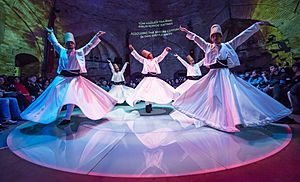Mevlevi Order facts for kids
|
Turkish: Mevlevi Dergahi
|
|
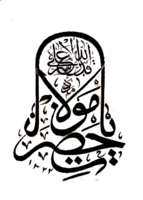
Seal of the Mevlevi
|
|
| Abbreviation | Mevlevi |
|---|---|
| Formation | 1273 |
| Founder | Veled |
| Founded at | Sultanate of Rum |
| Type | Dervish order |
| Headquarters | Konya, Turkey |
|
Membership
|
ca. 2,000 as of 2015 |
|
Makam Chalabi (Chief Master)
|
Faruk Hemdem |
|
Wali
|
Rumi |
|
Main organ
|
Diyanet |
| Mevlevi Sema Ceremony | |
|---|---|
|
UNESCO Intangible Cultural Heritage
|
|
| Country | Turkey |
| Reference | 00 |
| Region | Europe and North America |
| Inscription history | |
| Inscription | 2008 (3rd session) |
| List | Representative |
The Mevlevi Order (also called Mawlawiyya) is a special group of Sufi people. Sufism is a mystical part of Islam. This group started in Konya, Turkey. It was founded by followers of Jalaluddin Muhammad Balkhi Rumi. Rumi was a famous Persian poet, mystic, and thinker from the 1200s.
The Mevlevis are often called "whirling dervishes." This is because they have a famous practice of whirling around. They do this while performing dhikr, which means remembering God. A Dervish is a common name for someone who is learning the Sufi way of life. The whirling is part of a special ceremony called sema. The people who whirl are called semazens.
In 2005, UNESCO recognized "The Mevlevi Sema Ceremony" as an important part of the world's cultural heritage.
Contents
What Mevlevis Believe and Do
The Mevlevi Order is about 750 years old. It is based on the teachings of Rumi, also known as Mevlana. Rumi is one of Turkey's most famous poets. He is also seen as a great mystic in Islam. Rumi's friend and teacher, Shams of Tabriz, is also highly respected by the Mevlevis.
Mevlevis believe that love is the most important part of Islam. A Mevlevi teacher named Şefik Can said that Rumi teaches us to focus on the love of God. He also said to look for the true meaning of faith, not just the rules.
Besides regular Islamic worship, Mevlevis have other important spiritual practices:
- Studying the Quran and Rumi's writings. His poetic masterpiece, the Masnavi-e-Ma'navi, is very important.
- Muraqabah (Islamic meditation).
- Special conversations led by their teacher (called sohbet).
- Sema: the whirling ceremony.
- Dhikr: repeating God's names to make the heart pure.
- Adab (learning good manners and being mindful).
The Sema Whirling Ceremony
The most important Sema for the Mevlevi order is an annual celebration. It marks Rumi's death, which they call his "marriage to God." This event is also known as Seb-i Arus, meaning "Nuptial Night" or "Night of Union." It lasts for one week, ending on the anniversary of his death. People from all over the world travel to Konya, Turkey, for this celebration. It is so popular that you need tickets to attend.
Rumi wrote about whirling in some of his poems. In one poem, he said: "Those who turn in the direction of prayer, whirl in both this world and the next."
How the Sema Started
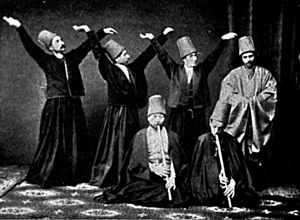
A popular story says Rumi was first inspired to whirl when he heard goldsmiths hammering in Konya's market. However, some historians believe Rumi learned whirling from his friend Shams of Tabriz. Some also think whirling was practiced by Sufis even before Rumi's time. While Mevlevis have perfected it, they are not the only Sufis who whirl. Some suggest it might come from ancient Central Asian spiritual practices.
What the Whirling Means
The Sema ceremony usually takes place in a special hall called a semahane. It follows a very specific ritual. The semazens (whirlers) spin in a circle around their teacher. They use their right foot to push themselves in a counter-clockwise circle. Their left foot stays on the floor, acting like a pivot. Both arms are raised to head level. The right palm points up to receive God's grace. The left palm points down to share that grace with the world. With each spin, the semazen quietly chants "Allah."
The semazens enter wearing a black cloak (hırka). This cloak symbolizes death and the grave. They take it off before they start whirling. On their heads, they wear a tall, brown hat called a sikke. This hat represents a tombstone and the death of their ego (their self-importance). Once their cloaks are off, their long white robes (tennûre) and white jackets (destegül) become visible. These white clothes symbolize new life or resurrection.
Parts of the Ceremony
- Naat-i Sharif – The ceremony begins with a solo singer praising the Prophet Muhammad. It ends with a reed flute (ney) improvisation. The flute's sound represents the Divine breath that gives life to everything.
- Devr-i Veled – This is a slow, rhythmic walk by the semazens. They walk in a single line around the hall three times. As they start each round, they bow to the semazen in front and behind them. This bow shows respect for the divine spirit in everyone. After this, the dervishes remove their black cloaks.
- The Four Salams – These are four main musical parts of the ceremony.
* The first selam is about a person's journey to truth and understanding God. * The second selam is about feeling joy when seeing the beauty of creation. * The third selam is about turning that joy into love. It means giving up one's own thoughts for love and becoming one with God. * The fourth selam is about accepting one's path in life. The semazen becomes a servant of God and all creation.
- Quranic Recitation – The ceremony ends with a reading from the Quran. A common verse read is: God is in the East and West. And wherever you turn, there is the face of God. (Quran 2:115)
History of the Mevlevi Order
How the Order Grew
Rumi's son, Sultan Veled, and Husameddin Chelebi started the Mevlevi Order after Rumi's death in 1273. Sultan Veled was also a poet. His poems are often sung during the sema ceremony. Both he and Husameddin Chelebi are respected Sufi mystics. They built Rumi's tomb in Konya, which is still a pilgrimage site today. Sultan Veled's son, Ulu Arif Chelebi, continued their work to establish the order.
During the Ottoman period, the Mevlevi order spread to many places. These included the Balkans, Syria, Egypt, and Jerusalem. The order became very strong in the Ottoman Empire. This happened when Devlet Hatun, a descendant of Sultan Veled, married Sultan Bayezid I. Their son, Mehmed I Çelebi, became the next sultan. He and later sultans gave the order many benefits. Many Mevlevi members held important jobs in the empire.
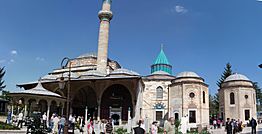
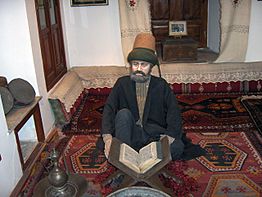
The Çelebis: Leaders of the Order
Today, the Mevlevi Order is led by Rumi's male descendants. The head of the order is called Çelebi. This means 'man of God' or 'noble'. The current Çelebi is Faruk Hemdem Çelebi. He also leads the International Mevlana Foundation. This foundation is a Turkish cultural and educational group. Teachers of Mevlevi practices are chosen by the Çelebi.
Artistic Contributions
The Mevlevi Order has a long history with the arts in Turkey. Rumi's Mathnavi and Diwan-e Shams-e Tabrizi are famous Persian literary works. Other Mevlevis also wrote important books and poems. Shaykh Ghalib Dede (died 1799) is considered one of the greatest Mevlevi poets after Rumi.
The music for the Mevlevi ceremony (called Ayin) is very special. It is complex and beautiful. It helps create a spiritual atmosphere for the ceremony. Many famous Turkish musicians were Mevlevis. Mustafa Itri (1640–1712) and Ismail Dede (1778-1846) are two of Turkey's greatest classical composers. Ismail Dede wrote music for the sema ceremony.
The Mevlevi Regiment
During World War I, a group called the Mevlevi Regiment served in Syria and Palestine. This group was made of about 800 dervishes. They were formed in Konya in 1914. This unit did not fight much and was disbanded in 1918.
Mustafa Kemal, who later founded the Turkish Republic, met with Mevlevi members in 1923.
The 1925 Ban in Turkey
In September 1925, Sufism was made illegal in Turkey. This was done by the new Turkish Republic under Atatürk. Because of this, the Dervish lodge in Konya became the Mevlana Museum.
Even though the Sufi lodges were closed, Mevlevi practices still continue in Turkey. They are done more privately. Sufism is still officially illegal in Turkey. So, sema ceremonies are presented as cultural events, not as religious worship.
Mevlevi Order in the West
In the late 1900s, the Mevlevi Order became known in Western countries. This was partly because Rumi's poetry was translated into English. A Mevlevi teacher named Süleyman Dede also helped. He traveled to the USA, Canada, and Europe in the 1970s. He appointed some Westerners as Mevlevi teachers for the first time.
Since the 1970s, Mevlevi dervishes have also performed the whirling ceremony for audiences in the West. Today, Mevlevi groups can be found around the world.
Women in the Mevlevi Order
Rumi had many important female students. In the early days of the order, there were even female teachers and semazens. For example, Destina Khatun was a female teacher of a Mevlevi lodge. In Rumi's time, men and women would sometimes pray and whirl together. Later, women often had their own separate semas. However, in 1991, the head of the order gave permission for men and women to whirl together again in mixed ceremonies.
Mevlevi Order and the Ottoman Empire
Early Support and Growth
The Mevlevi Order's connection with the Ottoman state began in the late 1300s. Sultan Murad I's Grand Vizier built a Mevlevi lodge in 1387. This helped the order become part of Ottoman culture. Later, Sultan Mehmed the Conqueror also supported the order. He built the first Mevlevi lodge in Istanbul. He also restored Rumi’s tomb in Konya.
The Mevlevi Order became very important under Sultan Selim III. He studied Mevlevi teachings, played the reed flute, and visited Mevlevi lodges. He also set up funds for teaching Rumi's Mathnawi in mosques. This time is often called the "golden age" for the Mevlevi Order.
Mevlevi Influence in Ottoman Life
By the late Ottoman period, the Mevlevi Order played a big role in state ceremonies. Sultan Mehmed V Reşâd showed great respect for the Mevlevi tradition. He involved the order in his crowning ceremony. This showed how deeply connected the Mevlevi Order was with the Ottoman rulers and their spiritual authority.
Artistic Contributions to the Empire
The Mevlevi Order also influenced Ottoman education and buildings. The Madrasa of Sultan Walad was built in Konya in 1584. It was named after Rumi’s son. This showed the lasting ties between the order and the ruling class. More recently, a conference hall named after Sultan Walad was added to the Mevlana Cultural Centre in Konya in 2004.
Images for kids
See also
 In Spanish: Mevleví para niños
In Spanish: Mevleví para niños


